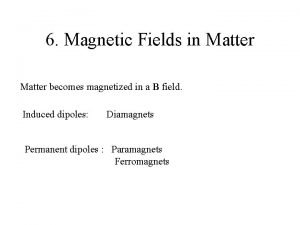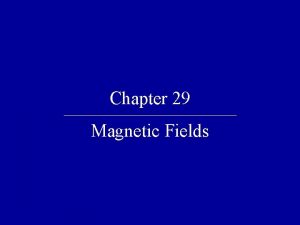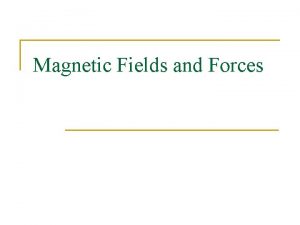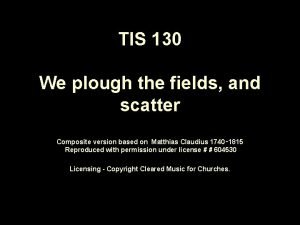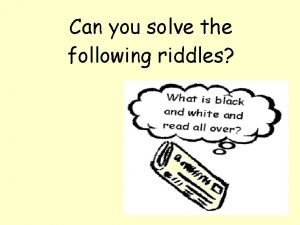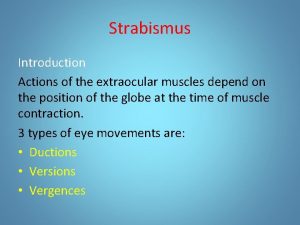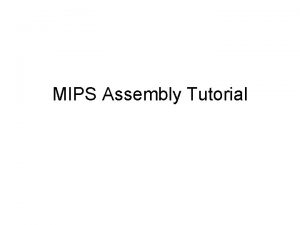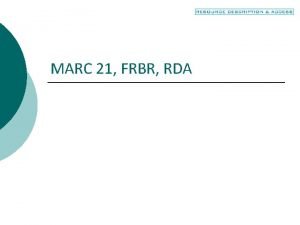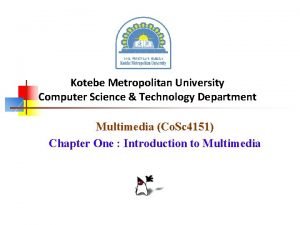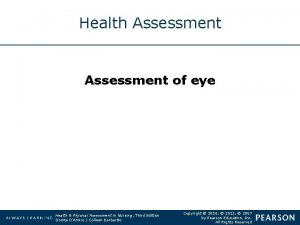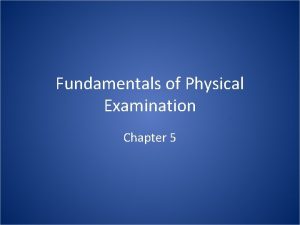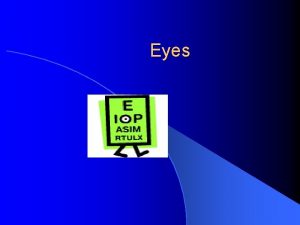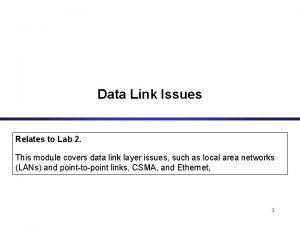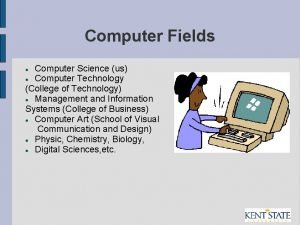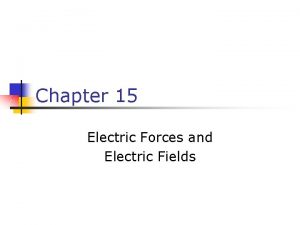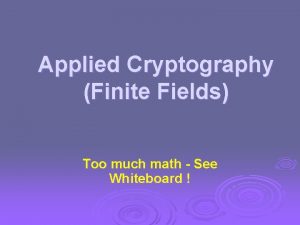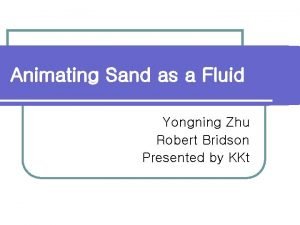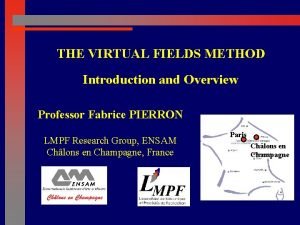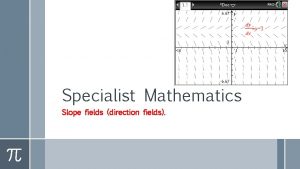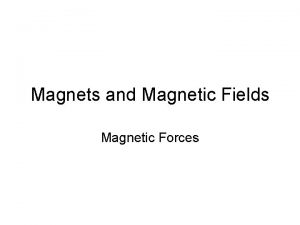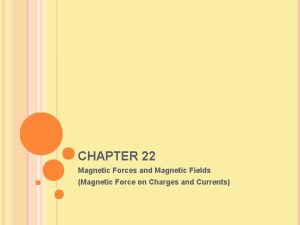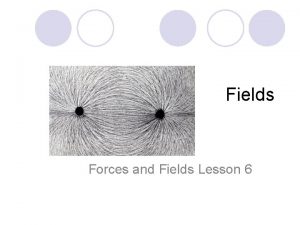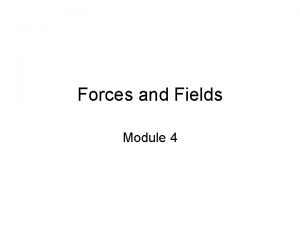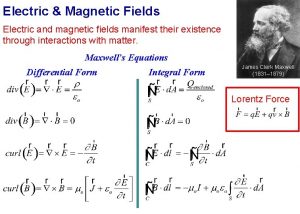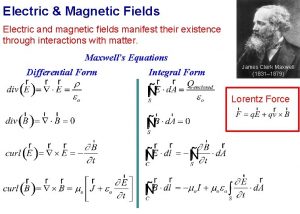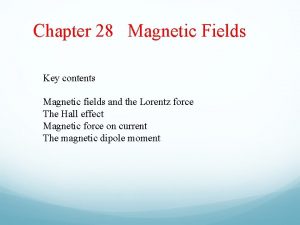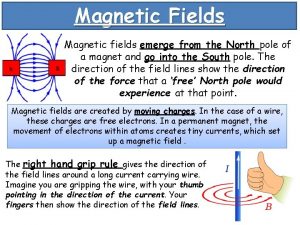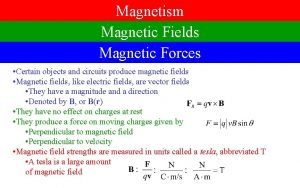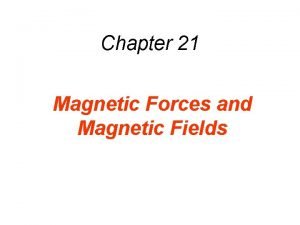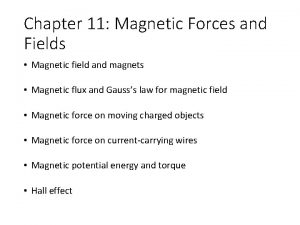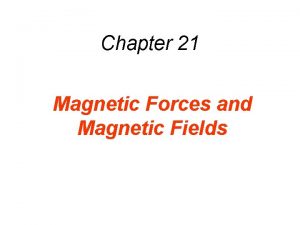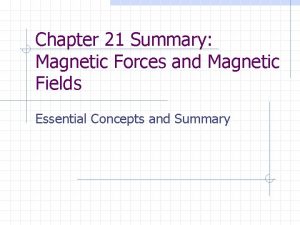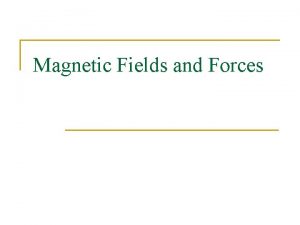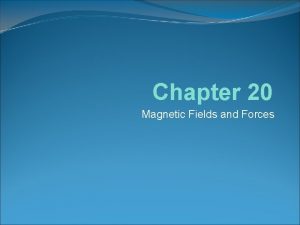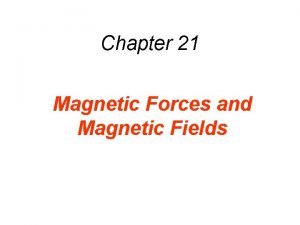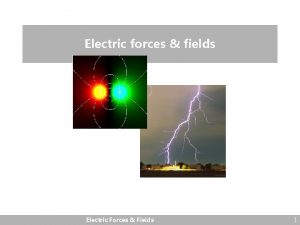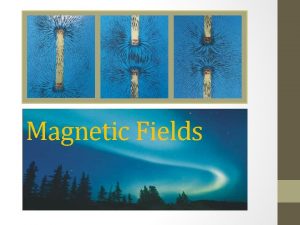Ch 21 Magnetic Forces and Fields 21 1
























































- Slides: 56

Ch. 21 - Magnetic Forces and Fields

21. 1 Magnetism • Chinese scientists first used the lodestone compass for navigation in the 12 th century. • By the beginning of the 17 th century, Europeans understood that compasses worked because the Earth itself was a magnet. • Today we know this is due to the interaction between the solid and molten parts of the Earth’s iron core.

21. 1 Magnetic Fields The behavior of magnetic poles is similar to that of like and unlike electric charges.

21. 1 Magnetic Fields The needle of a compass is permanent magnet that has a north magnetic pole (N) at one end a south magnetic pole (S) at the other. The north pole of a magnet is attracted to the south pole of another magnet. The geographic North Pole is actually a south magnetic pole.

21. 1 Magnetic Fields • Surrounding a magnet there is a magnetic field, an “alteration of space” caused by the magnet. • The direction of the magnetic field at any point in space is the direction indicated by the north pole of a small compass needle placed at that point. • The variable we use for the magnetic field is • The SI unit for magnetic field strength is the (N-s)/(C-m), the tesla, T.

The Aurora Borealis (Northern Lights) and Aurora Australis (Southern Lights) occur near the poles, where the Earth’s magnetic field is the strongest.

The compass and magnetic field lines http: //phet. colorado. edu/en/simulation/magnetsand-electromagnets

Magnetism • An understanding of the relationship between electricity and magnetism began in 1819 with work by Oersted, who discovered that an electric current could influence a compass needle. • Later in the 19 th century, Faraday and Maxwell and others unified electricity and magnetism into the study of electromagnetism. An electromagnetic wave consists of propogating electric (E) and magnetic (B) fields.

Moving charge is a magnet and has a magnetic field http: //phet. colorado. edu/en/simulation/magnetsand-electromagnets

3 D- visualization of vectors and current

MAGNETIC FIELD OF A LONG, STRAIGHT WIRE • The magnetic field due to a long straight current-carrying wire is circular in shape. • The magnitude, (magnetic field strength) is inversely proportional to the distance from the wire. Spacing of field lines increases with distance. • The field strength is: Where μ 0 the permeability of free space, a fundamental constant of magnetism: = 1. 257 x 10 -6 T m/A B = (2 x 10 -7)I r

21. 7 Magnetic Fields Produced by Currents Right-Hand Rule No. 2. Curl the fingers of the right hand into the shape of a half-circle. Point the thumb in the direction of the conventional current, and the tips of the fingers will point in the direction of the magnetic field.

In what direction does the magnetic field point at position P? A. Up B. Down C. Into the page D. Out of the page

Finding the magnetic field strength, B The long straight wire carries a current of 3. 0 A. Determine the magnitude of the magnetic field at a distance of 0. 050 m from the wire.

Finding the magnetic field strength, B The long straight wire carries a current of 3. 0 A. Determine the magnitude of the magnetic field at a distance of 0. 050 m from the wire. B = 1. 2 x 10 -5 Tesla

Superposition of magnetic fields Which statement is true? A. The magnetic field is equal at 1, 2 and 3 B. The magnetic field is 0 at 2 C. The magnetic field is greatest at 2

Superposition of magnetic fields Calculate the magnetic field strength and direction at points 1, 2, and 3

Superposition of magnetic fields Calculate the magnetic field strength and direction at points 1, 2, and 3. B 1 = 6. 67 x 10 -5 T out of the page B 2 = 2 x 10 -4 T into the page B 3 = 6. 67 x 10 -5 T out of the page

Worksheet

Current Loops are Magnets The RHR 2 (for fields) shows the direction of the magnetic field in the center of the wire. http: //phet. colorado. edu/en/si mulation/magnets-andelectromagnets

The magnetic field of a current loop: 2 views

Comparison of fields of current loop and magnet

A current loop is a magnet • The magnetic field of the current loop exerts a force on the poles of the bar magnet (and vice versa). • The direction of the B field of loop: • Direction of force: • B field of bar magnet not shown

21. 7 Magnetic Fields Produced by Currents B field Direction of force on loops

A THIN LOOP OF WIRE The magnetic field center of circular loop of N turns is: I = current through the loop R = radius of the loop μ 0 = permeability of free space This formula is appropriate if the radius of the loop is greater than it’s thickness, but not for a solenoid.

Finding the Net Magnetic Field A long straight wire carries a current of 8. 0 A and a circular loop of wire carries a current of 2. 0 A and has a radius of 0. 030 m. Find the magnitude and direction of the magnetic field at the center of the loop. Explain why B 1 is in the upward direction and B 2 is in the downward direction. Why is it a good first guess that B 1 > B 2 ?

21. 7 Magnetic Fields Produced by Currents

What is the current direction in the loop (as seen from above) and which end is the north pole? A. CW – top B. CW – bottom C. CCW – top D. CCW - bottom

Magnetic force on a moving charge due to an external magnetic field • By virtue of its motion, any moving charge is a magnet whether positive or negative. • In the presence of an external magnetic field, the charge will experience a force (we ignore the tiny field due to the charge itself. • If the net force is non-zero, the particle will accelerate in accordance with Newton’s 2 nd Law. • Recall that acceleration results in a change in either speed OR direction.

The direction of the magnetic force on a charge moving in an external B field Right Hand Rule No. 1. Extend the right hand so the fingers point along the direction of the magnetic field and the thumb points along the velocity of the charge. The palm of the hand then faces in the direction of the magnetic force that acts on a positive charge. If the moving charge is negative, use the left hand.

The magnitude of the magnetic force on a charge moving in an external B field |Fm|= qv. B(sinθ) • θ is the angle between the direction of motion and the direction of B • B is an external field caused by magnetic objects that are not always shown F=0 F<Fmax F = Fmax

Magnetic Force on a moving charge due to an external B field Fm = qv. Bsinθ • Only a moving charge experiences a force. • θ is the angle between the direction of motion and the direction of B. There is no force if sin θ = 0 • Therefore, there must be a component of velocity perpendicular to the external field, or F = 0.

Magnetic Force on a moving charge due to an external B field Fm = qv. Bsinθ • The force is mutually perpendicular to v and B. • The force on a negative moving charge is shown by the left hand rule!

Conceptual Problem A positive charge is traveling in the direction shown by the arrow. It enters the external B field The particle experiences a force: a. to the right b. to the left c. into the page d. out of the page Out of the page

21. 3 The Motion of a Charged Particle in a Magnetic Field • The magnetic force always remains perpendicular to the velocity. • A constant force perpendicular to velocity results in a centripetal acceleration and uniform circular motion. Recall: • According to Newton’s Law, F = ma For the magnetic force on a charged particle

21. 4 The Mass Spectrometer Chemists and biologists use the “mass spec” to identify the mass and/or charge of molecules.

21. 4 The Mass Spectrometer The mass spectrum of naturally occurring neon, showing three isotopes.

How much Deuterium in my sample? Deuterium, (“heavy hydrogen”) has an extra neutron in its nucleus, along with its one proton. Researchers want to know the percentage of deuterium in a sample of hydrogen. The hydrogen is stripped of its electron, and then is accelerated through the metal plates with a potential difference of 2100 Volts. It then enters a uniform B field 0. 1 T, out of the page. Ignore effects due to gravity. At what radius should the detector be placed to detect the deuterium? mp = mn = 1. 67 x 10 -27 kg q = e = 1. 60 x 10 -19 C v = 4. 5 x 105 m/s (from conservation of energy).

How much Deuterium in my sample? Use Newton’s Law to find an expression for r: r = 9. 4 x 10 -2 m

Ranking Task 3 particles move in a mass spectrometer with a B field pointing out of the page. They have the same mass and speed. Rank the particles in order of charge magnitude, greatest to least: a. 3, 2, 1 b. 3, 1, 2 c. 2, 3, 1 d. 1, 3, 2 e. 1, 2, 3

21. 3 The Motion of a Charged Particle in a Magnetic Field Conceptual Example 2 A Velocity Selector A velocity selector is a device for measuring the velocity of a charged particle. The device operates by applying electric and magnetic forces to the particle in such a way that these forces balance. How should an electric field be applied so that the force it applies to the particle can balance the magnetic force? A. up B. down C. left D. right

21. 5 The Force on a Current in a Magnetic Field The magnetic force on the moving charges pushes the wire to the right.

21. 5 The Force on a Current in a Magnetic Field The magnetic force on each moving charge

Force on a wire In New York City, the earth's magnetic field has a vertical component of 5. 2 x 10 -5 T that points downward (perpendicular to the ground) and a horizontal component of 1. 8 x 10 -5 T that points toward geographic north (parallel to the ground). What is the magnitude and direction of the magnetic force on a 16. 0 m long, straight wire that carries a current of 16 A perpendicularly into the ground?

Force on a wire In New York City, the earth's magnetic field has a vertical component of 5. 2 x 10 -5 T that points downward (perpendicular to the ground) and a horizontal component of 1. 8 x 10 -5 T that points toward geographic north (parallel to the ground). What is the magnitude and direction of the magnetic force on a 16. 0 m long, straight wire that carries a current of 16 A perpendicularly into the ground? Ans: 4. 6 x 10 -3 Newtons pointing east

21. 6 The Torque on a Current-Carrying Coil • The two forces on the loop have equal magnitude but an application of RHR-1 shows that they are opposite in direction, causing the loop to rotate. • There is no net force, but there is a net Torque about the shaft. • Of course we all remember torque!

21. 6 The Torque on a Current-Carrying Coil • The loop tends to rotate such that its • normal becomes aligned with the magnetic field. • At this point there will no longer be a torque.

What happens to the loop? The magnetic field exerts: a. a net force and a net torque b. a net force but no net torque c. a net torque, but no net force d. neither a net force, nor a net torque

What happens to this loop? B = 0. 25 T, I = 12 A Single turn square with sides of 0. 32 m length Part 1: Is there a torque? a. yes, top out of the page, bottom into the page b. yes, left side out of the page, right side into the page c. no torque

21. 6 The Torque on a Current-Carrying Coil number of turns of wire

What happens to this loop? B = 0. 25 T, I = 12 A Single turn square with sides of 0. 32 m length Part 2: What is the magnitude of the torque?

What happens to this loop? B = 0. 25 T, I = 12 A Single turn square with sides of 0. 32 m length Part 2: What is the magnitude of the torque? = F(L/2)top + F(L/2)bottom Or = NIAB =. 307 N-m

The Basics of the DC Motor • The armature refers to the coil of wire (usually more than one!) wound around an iron core. • The “brushes” are conductive. • The half-rings are commonly called the commutator. Their job is to reverse the current.

The Basics of the DC Motor-1 The magnetic field of the magnet exerts a torque on the loop (armature) causing it to turn clockwise. Note the numbers on each side of the commutator. Each person should make a sketch 1 2

The Basics of the DC Motor-2 2. Look closely at the half-rings and the brushes. Is there a force on the loop? If so what causes it? If not, explain why is the motor still spinning? Or is it? 2

The Basics of the DC Motor -3 You draw in the following: • The forces on the sides of the loops • The direction of the current • The numbers on each side of the commutator • The direction the motor is turning
 Learning: module 26: magnetic forces and fields
Learning: module 26: magnetic forces and fields Red fields to green fields
Red fields to green fields Lesson outline magnets and magnetic fields answer key
Lesson outline magnets and magnetic fields answer key Electric currents and magnetic fields
Electric currents and magnetic fields Electric currents and magnetic fields
Electric currents and magnetic fields Electric forces and fields concept review
Electric forces and fields concept review Chapter 16: electric forces and fields answers
Chapter 16: electric forces and fields answers Magnetic field in matter
Magnetic field in matter Lesson quiz 29-1
Lesson quiz 29-1 Types of ferrites
Types of ferrites Flux density unit
Flux density unit Magnetic moment and magnetic field relation
Magnetic moment and magnetic field relation F=i(lxb)
F=i(lxb) Resultant of two unlike parallel forces
Resultant of two unlike parallel forces Contact forces
Contact forces Balanced forces and unbalanced forces venn diagram
Balanced forces and unbalanced forces venn diagram Constructive forces and destructive forces
Constructive forces and destructive forces About magnets
About magnets The forces shown above are pushing/pulling forces
The forces shown above are pushing/pulling forces Intermolecular forces from strongest to weakest
Intermolecular forces from strongest to weakest Intermolecular forces ranked
Intermolecular forces ranked Intermolecular force of attraction
Intermolecular force of attraction We plough the fields and scatter
We plough the fields and scatter New consultant training
New consultant training Banana dresser grammar potato revive
Banana dresser grammar potato revive Continuity equation for time varying field
Continuity equation for time varying field Branches of psychology
Branches of psychology Chapter 33 electric fields and potential
Chapter 33 electric fields and potential Multiplicative inverse
Multiplicative inverse Norm rule fields
Norm rule fields How many fields in computer science
How many fields in computer science Why is tactile fremitus increased in pneumonia
Why is tactile fremitus increased in pneumonia Cover uncover test vs alternating cover test
Cover uncover test vs alternating cover test 6 cardinal fields of gaze
6 cardinal fields of gaze Stealing by carol ann duffy analysis
Stealing by carol ann duffy analysis Slope fields ap calculus
Slope fields ap calculus Assembly mips tutorial
Assembly mips tutorial Rda fields
Rda fields Kotebe metropolitan university fields
Kotebe metropolitan university fields Six cardinal fields of gaze
Six cardinal fields of gaze Percussion of lung fields
Percussion of lung fields L
L Empower sample set generators
Empower sample set generators Tumor treating fields mechanism of action
Tumor treating fields mechanism of action Ethernet ii frame fields
Ethernet ii frame fields How many fields in computer science
How many fields in computer science Electric fields quiz
Electric fields quiz Finite fields in cryptography
Finite fields in cryptography Wo yongning
Wo yongning Binary fields
Binary fields How to read slope fields
How to read slope fields Virtual fields method
Virtual fields method Virtual fields method
Virtual fields method How to draw slope fields
How to draw slope fields Please fill in all fields
Please fill in all fields Into the fields internship
Into the fields internship In flanders fields summary
In flanders fields summary







